导读:(1)绘制多边形 (2)绘制空心多边形 (3)绘制多条线来制作注视点 (4)绘制多色和单色的棋盘格 (5)绘制次序 (6)同时对比错觉 (7)[r g b a]中α通道
绘制多边形的思路:先设置边,再得到各点坐标,之后是其他属性,最后绘制→(1)、(2)
绘制矩形思路:先设置基本矩形和中心点的坐标,然后获取以中心点为中心后的矩形坐标→(4) 、(5) 、(6) 、(7)
绘制线思路:先设置臂长,据此设置起点和终点坐标,再进行绘制→(3)
1.Polygon Demo: 如何绘制具有任意边数的多边形
(1) Screen('FillPoly',w,color,pointlist,isConvex) 绘制实心多边形
w 窗口指针 color 颜色 pointlist 多边形顶点矩阵(2*n),每行的两个值为一个顶点坐标值 isConvex是否为凸多边形(默认1,1为凸,2为凹)
% Number of sides for our polygon 多边形的边数
numSides = 7; % Angles at which our polygon vertices endpoints will be. We start at zero 多边形顶点处的角度 % and then equally space vertex endpoints around the edge of a circle. The 从0开始,在圆的周围均匀分布顶点,然后依次连接这些点来定义多边形 % polygon is then defined by sequentially joining these end points. anglesDeg = linspace(0, 360, numSides + 1); anglesRad = anglesDeg * (pi / 180); radius = 200; % X and Y coordinates of the points defining out polygon, centred on the 获取这些点的坐标(以屏幕中心为中心点) % centre of the screen yPosVector = sin(anglesRad) .* radius + yCenter; xPosVector = cos(anglesRad) .* radius + xCenter; % Set the color of the rect to red 设置颜色 rectColor = [1 0 0]; % Cue to tell PTB that the polygon is convex (concave polygons require much 告知PTB这个多边形是凸的 % more processing) isConvex = 1; % Draw the rect to the screen 绘制(这里对坐标数组进行转置,是由于点坐标这一参数的要求,2*n的矩阵,每行为一个点的坐标) Screen('FillPoly', window, rectColor, [xPosVector; yPosVector]', isConvex); % Flip to the screen Screen('Flip', window);
示意图
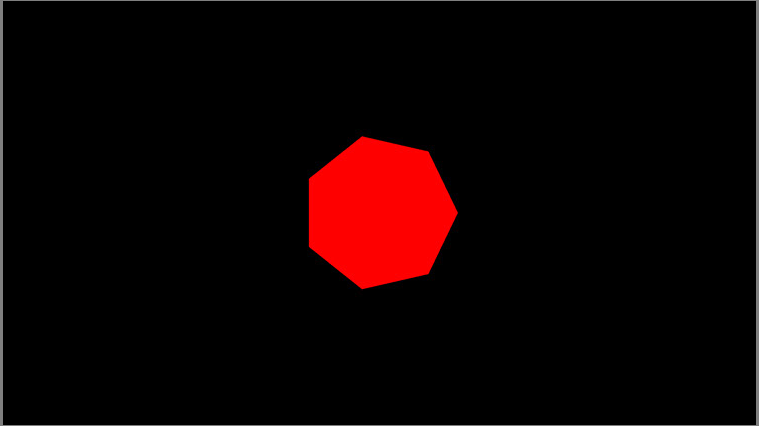
2.Framed Polygon Demo: 绘制空心多边形
(1) Screen('FramePoly',w,color,pointlist,penwidth) 绘制空心多边形
w 窗口指针 color 颜色 pointlist 多边形顶点矩阵(2*n),每行的两个值为一个顶点坐标 penwidth 为画笔粗细,像素为单位,默认为1
注:与FillPoly的参数基本一致,只是最后对画笔的粗细进行了设置
% Number of sides for our polygon numSides = 7; % Angles at which our polygon vertices endpoints will be. We start at zero % and then equally space vertex endpoints around the edge of a circle. The % polygon is then defined by sequentially joining these end points. anglesDeg = linspace(0, 360, numSides + 1); anglesRad = anglesDeg * (pi / 180); radius = 200; % X and Y coordinates of the points defining out polygon, centred on the % centre of the screen yPosVector = sin(anglesRad) .* radius + yCenter; xPosVector = cos(anglesRad) .* radius + xCenter; % Set the color of the rect to red rectColor = [1 0 0]; % Width of the lines for our frame lineWidth = 10; % Draw the rect to the screen Screen('FramePoly', window, rectColor, [xPosVector; yPosVector]', lineWidth); % Flip to the screen Screen('Flip', window);
示意图
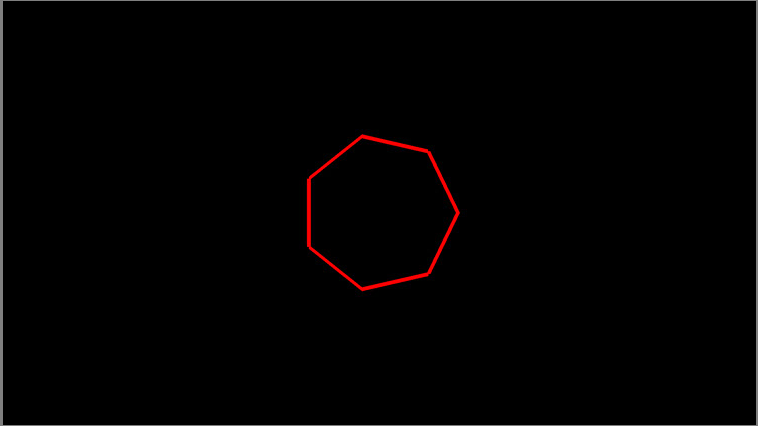
3.Fixation Cross Demo: 如何绘制多条线来制作注视点
(1) Screen('DrawLine',w,color,fromH,fromV,toH,toV,penwidth) 绘制单线
w 窗口指针 color 颜色 fromh,fromv起点坐标 toh,tov终点坐标 penwidth线条宽度
(2) Screen('DrawLines',w,xy,width,color,center,smooth) 一次性绘制多条线
w 窗口指针 xy为2*2n的矩阵,n为线条数,第一行x坐标,第二行y坐标,第一二列是第一条线的起点和终点,以此类推
width线条宽度,一个值则都相同,否则取值数同线条数相同,默认为1
color颜色 一个值则都相同,否则同坐标列数相同(每相邻的两个颜色分别对应起点与终点颜色,依据线性插值计算线条上各点颜色),默认为白
center 中心点,默认(0,0) smooth线条平滑度,默认为0,取1表示反锯齿,且需使用Screen('BlendFunction')
% Here we set the size of the arms of our fixation cross 设置注视点长度/臂的大小 fixCrossDimPix = 40; % Now we set the coordinates (these are all relative to zero we will let 设置坐标 % the drawing routine center the cross in the center of our monitor for us) 让这个注视点的中心是显示器的中心点 xCoords = [-fixCrossDimPix fixCrossDimPix 0 0]; yCoords = [0 0 -fixCrossDimPix fixCrossDimPix]; allCoords = [xCoords; yCoords]; % Set the line width for our fixation cross 设置线条宽度 lineWidthPix = 4; % Draw the fixation cross in white, set it to the center of our screen and 绘制。设置为白色,以显示器的中心点为中心,并有好的反锯齿效果 % set good quality antialiasing Screen('DrawLines', window, allCoords,... lineWidthPix, white, [xCenter yCenter], 2); % Flip to the screen Screen('Flip', window);
示意图

4.Checker-Board Demo:在先前演示的基础上,展示如何构建一个多色(左)和黑白(右)棋盘格。
思路:所用到的函数在先前都已讲解过。这里首先设置一个边长50的基本矩形。然后设置一个网格,并对网格的属性进行了调整(即点的位置坐标),网格中的这些点的坐标
是之后调整基本矩形坐标的中心点。值得注意的是,在控制黑白格的颜色属性时用到的是eye(n)函数,它对角线为1,其余位置原色为0.而这一函数在之后也会见到
% Make a base Rect of 50 by 50 pixels 设置基本矩阵 dim = 50; baseRect = [0 0 dim dim]; % Make the coordinates for our grid of squares 制作方形格的坐标 [xPos, yPos] = meshgrid(-2:1:2, -2:1:2); % Calculate the number of squares and reshape the matrices of coordinates 计算方形数量,并制作坐标向量 % into a vector [s1, s2] = size(xPos); numSquares = s1 * s2; xPos = reshape(xPos, 1, numSquares); yPos = reshape(yPos, 1, numSquares); % Scale the grid spacing to the size of our squares and centre 调整网格间距 xPosLeft = xPos .* dim + screenXpixels * 0.25; yPosLeft = yPos .* dim + yCenter; xPosRight = xPos .* dim + screenXpixels * 0.75; yPosRight = yPos .* dim + yCenter; % Set the colors of each of our squares 设置颜色 multiColors = rand(3, numSquares); bwColors = repmat(eye(2), 3, 3); bwColors = bwColors(1:end-1, 1:end-1); bwColors = reshape(bwColors, 1, numSquares); bwColors = repmat(bwColors, 3, 1); % Make our rectangle coordinates 制作矩形坐标 allRectsLeft = nan(4, 3); allRectsRight = nan(4, 3); for i = 1:numSquares allRectsLeft(:, i) = CenterRectOnPointd(baseRect,... xPosLeft(i), yPosLeft(i)); allRectsRight(:, i) = CenterRectOnPointd(baseRect,... xPosRight(i), yPosRight(i)); end % Draw the rect to the screen Screen('FillRect', window, [multiColors bwColors],... [allRectsLeft allRectsRight]); % Flip to the screen Screen('Flip', window);
示意图
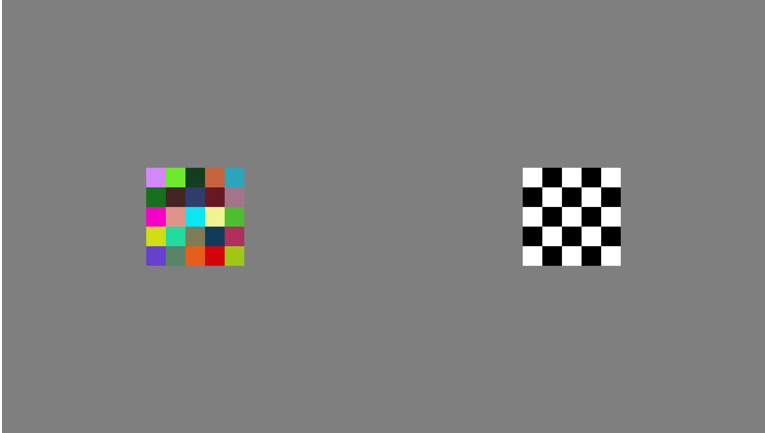
5.Order Of Drawing Demo: .这个演示了顺序绘图。这是在屏幕上绘制多个对象的关键,例如重叠对象。
注:所涉及函数之前都有介绍。左手边是分别执行命令,右手边则通过一条代码实现两个矩形的绘制。注意绘制的次序问题,这里先绘制的矩形(红)被后后绘制的矩形|(绿)所覆盖
% Make a base Rect of 200 by 200 pixels. 设置基本矩形
baseRect = [0 0 200 200];
% Center the left hand side squares on positions in the screen. 矩形居中到屏幕左手边位置
leftBackRect = CenterRectOnPointd(baseRect, screenXpixels * 0.25, yCenter);
leftForwardRect = CenterRectOnPointd(baseRect,...
screenXpixels * 0.25 + 100, yCenter + 100);
% Do the same of the right hand side squares, but not concatonate these 右手边
% into a single matrix. This is bacause we will be drawing these both in a
% single line of code.
rightBackRect = CenterRectOnPointd(baseRect,...
screenXpixels * 0.75, yCenter);
rightForwardRect = CenterRectOnPointd(baseRect,...
screenXpixels * 0.75 + 100, yCenter + 100);
rightRects = [rightBackRect; rightForwardRect]'; 注意这里的转置符号
% We do the same of the colors of the rects. Put them in one matrix for 设置颜色
% drawing
rightRectColors = [1 0 0; 0 1 0]';
% Draw the left hand side squares onto the screen, we do this sequentially 绘制左手边矩形
% with two lines of code, one for each rectangle.
Screen('FillRect', window, [1 0 0], leftBackRect);
Screen('FillRect', window, [0 1 0], leftForwardRect);
% Now we draw the two right hand side squares to the screen. We get the 绘制右手边矩形
% same results as if we draw in two seperate lines, however we efficiently
% draw both squares in a single line of code. Note, that as detailed above,
% we acheive the same ordering of squares by placing the coordinates of the 将首先要绘制的矩形坐标放入坐标矩阵,以实现相同的正方形顺序
% square we want to draw first into the matrix first.
Screen('FillRect', window, rightRectColors, rightRects);
% Flip to the screen.
Screen('Flip', window);
示意图
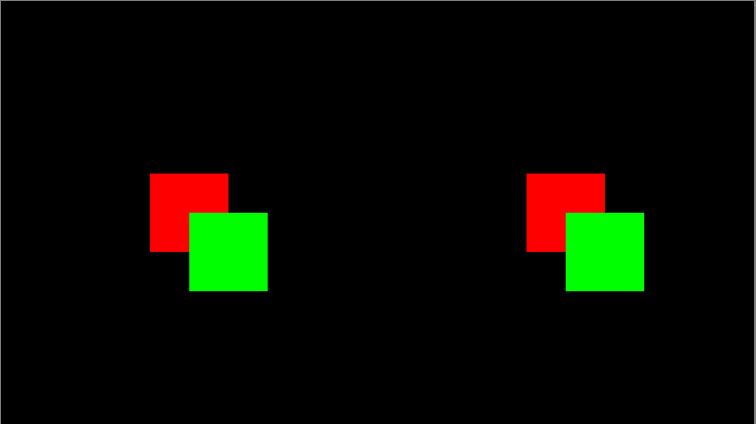
6.Simultaneous Contrast Illusion Demo:绘制一个简单的同时对比错觉。这一次所有的对象绘制在一行代码中实习。
注:这里的同事对比错觉(明度对比现象)是指,两个相似的灰色方形,亮度相同,由于背景的原因出现不同的灰色阴影。白色背景下的更暗。
% Make a base Rect of 1/2 screen Y dimension for the black and white 分别制作一个边长为显示器y维度一半和六分之一的矩形
% background squares, and 1/6 for the front grey squares. This will produce
% a standard simultaneous contrast illustion where the two smaller grey
% sqaures, although the same luminance will appear different shades of grey
% due to being on different backgrounds. The one on the white background
% square will look darker then the one on the white background square.
backDim = screenYpixels / 2;
baseRectBack = [0 0 backDim backDim];
frontDim = screenYpixels / 6;
baseRectFront = [0 0 frontDim frontDim];
% Position the rectangles on the screen 制作矩形位置坐标
backLeftRect = CenterRectOnPointd(baseRectBack,...
xCenter - backDim / 2, yCenter);
backRightRect = CenterRectOnPointd(baseRectBack,...
xCenter + backDim / 2, yCenter);
frontLeftRect = CenterRectOnPointd(baseRectFront,...
xCenter - backDim / 2, yCenter);
frontRightRect = CenterRectOnPointd(baseRectFront,...
xCenter + backDim / 2, yCenter);
% Make a marix of all the rect coordinates
allRects = [backLeftRect; backRightRect; frontLeftRect; frontRightRect]'; 注意转置符号
% We do the same of the colors of the rects. Put them in one matrix for 颜色同理
% drawing
allColors = [white white white; black black black;...
grey grey grey; grey grey grey]';
% Draw all the rects in one line of code
Screen('FillRect', window, allColors, allRects);
% Flip to the screen.
Screen('Flip', window);
示意图
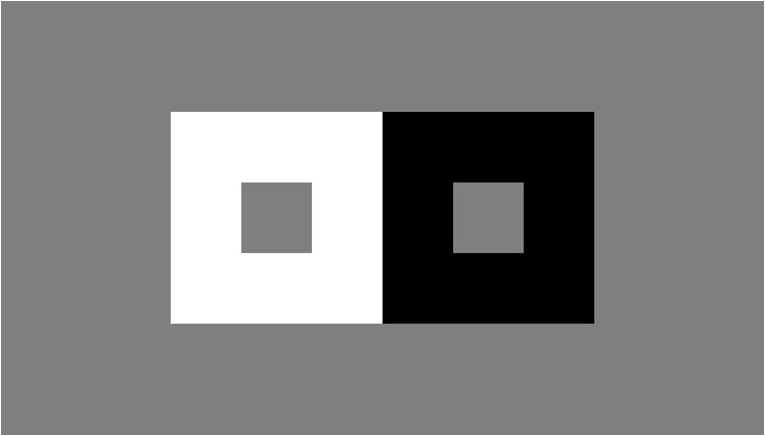
7.Semi-Transparent Squares Demo:如何使用“alpha”通道使图形半透明,以便您可以部分地“看穿图形”到后面的图形。同样,操作的顺序也是关键。
% Make a base Rect of 400 by 400 pixels 制作基本矩形
baseRect = [0 0 400 400];
% Screen X positions of our three rectangles 三个矩形的中心坐标
squareXpos = [xCenter - 200 xCenter + 200 xCenter];
squareYpos = [yCenter yCenter yCenter + 200];
numSqaures = length(squareXpos);
% Set the colors to Red, Green and Blue, with the fourth value being the 设置颜色[r g b a],第四个参数α值指透明度,1位完全不透明,0为完全透明
% "alpha" value. This also takes a value between 0 and 1 just like a
% normal colour, however now 0 = totally transparent and 1 = totally
% opaque. Our RGB triplets are now RGBA values.
allColors = [1 0 0 1; 0 1 0 1; 0 0 1 0.5]';
% Make our rectangle coordinates 制作矩形坐标
allRects = nan(4, 3);
for i = 1:numSqaures
allRects(:, i) = CenterRectOnPointd(baseRect,...
squareXpos(i), squareYpos(i));
end
% Draw the rect to the screen 绘制
Screen('FillRect', window, allColors, allRects);
% Flip to the screen
Screen('Flip', window);
示意图
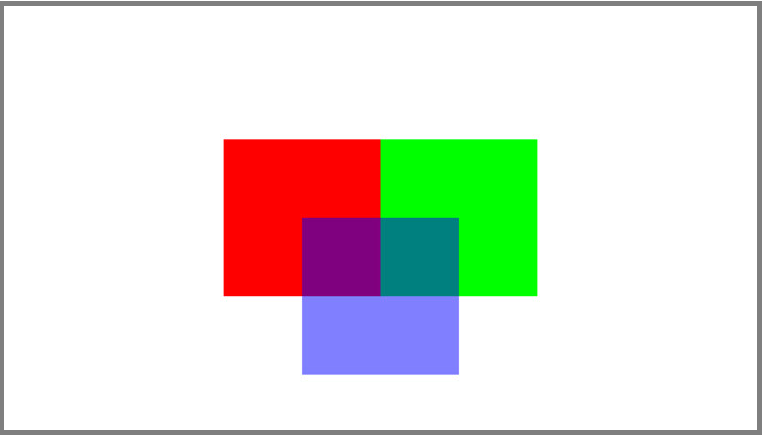






 浙公网安备 33010602011771号
浙公网安备 33010602011771号